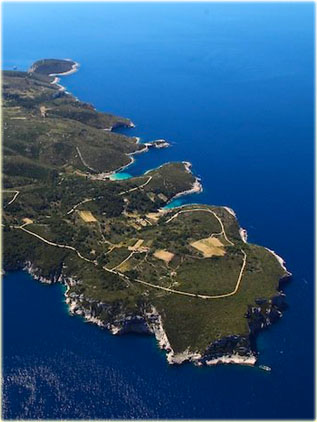
The island of Biševo (local dialect: Bisovo, Italian: Busi) is an island located in the centre of the Dalmatian archipelago, five kilometres southwest of the island of Vis, with population of 19 people (2011. census data) and with surface area of 5.92 square kilometres and with 18.147 km long coast. Many archaeological findings confirm that the island has been inhabited since prehistoric times, as well as in ancient Greek and ancient Roman times. In 1050. priest Ivan from Split founded the Benedictine monastery of "St. Sylvester the Pope" on Biševo which was soon abandoned because of the danger of the pirates. Along with the ruins of the monastery, the remains of the original church of St. Sylvester, built in 11th century are located. In today's church, a part of the inscription of priest Ivan, the founder of the monastery, and a fragment of the Greek epitaph times are embedded.
Since the beginning of the Second World War when there were around permanent 200 inhabitants on the island, the population of the island has steadily declined. The main settlement on the island was Polje, where there was a school until 1961. and now it is uninhabited. Other settlements on the island are: Salbunora, Porat, Mezuporat, Vela Gora, Potok, Nevaja, Gornja Salbunora. Biševo is the most remote Croatian inhabited island, connected only with island Vis with a boat line that operates across 4 mile wide channel of Bisevo, one of the most dangerous sea crossing in the Adriatic. Due to its geographical position, the island of Biševo is mainly exposed to high waves and strong winds from the west, but also south and north. Quiet sea is relatively rare. On the island of Biševo there is no water supply network nor the drainage system, which is one of the main reason for the continued depopulation. Most of the inhabitants moved to nearby Komiža, and have remained attached to their island where they still have vineyards and olive groves, and where they mainly reside during the the summer . The island of Biševo is protected by EU environmental standards Natura 2000, and soon it is expected that an underground biological wastewater treatment plant will be installed.
The main income for the population over the centuries was fishing and cultivation of grape vine, olives and figs. The island itself is composed mainly of limestone, with its highest point being Straženica, with 239 m in height, located on the southern part of the island. In the centre of the island there is a fertile field, and the rest of the island was covered in thick forest until 2003, when large fire devastated the southern part of the island. Today, only the northern part of the island is covered with pine forests and the rest of the island is covered with densely growing evergreen shrubs. The sea off the coast of the island of Bisevo has always been known among the fishermen of Komiza as a rich fishing area. Today, tourism and hospitality are the main sources of income, with just few vineyards of famous "Plavac Mali" grape vine variety.
Most of coastline is represented by high cliffs and high overhanging walls, while some of the most beautiful beaches are located in several bays. Stony shore of the island hides many bays and coves, as well as a large number of caves (26 according to some authors). Of the numerous coastal caves, the most famous are Modra or Biševska cave and Medvedina. Cave Medvidina is located on the southern coast of the island, below the highest peak of the island, the Straženice. Medvidina is 160 meter deep long cave that narrows down to the end, where small pebble beach is located. The cave used to be inhabited by Mediterranean monk seal, and it was named after it. The entrance to the cave is 14 metres wide and 20 meters high. The blue cave of Biševo (Blue grotto) is located on the eastern coast of the island Bisevo in the bay Balun. It consists of two halls, with total length of 36 m. It was hollowed by waves and it is partly submerged. Through a natural opening below the sea level sunlight at mid-day penetrates to the white rocks on the bottom, where they are reflected to illuminate the walls of the cave in blue and objects under the water ain silvery color. The cave has always been known to local population, but it was popularised by the Austrian diplomat and naturalist Eugene Ransonnet-Villez since 1884. The Bisevo cave is protected since 1951. as a geomorphological monument of nature. The proof that the sea around Biševo still hides many secrets is a recent discovery of another wreckage of the aircraft from Second World War, most likely heavy bomber B24 Liberator, at a depth of 85-90 meters and on the western side of the island. There are several nice beaches on the island of Biševo, most popular being sand beaches in Porat and Salbunora and pebble beach in Mezuporat. The accommodation is available in private apartments and houses, and good local food can be tasted in several small restaurants.







